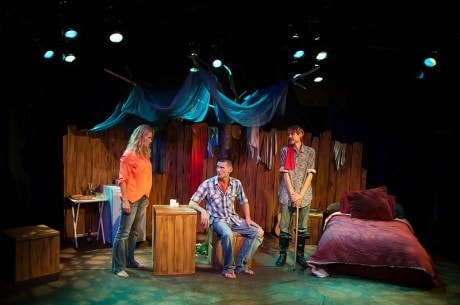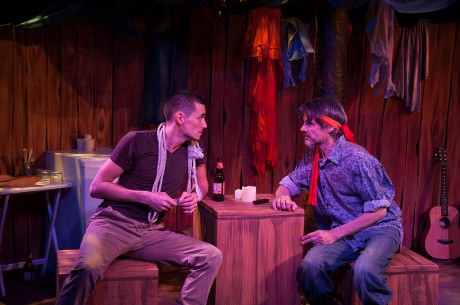In Ambassador Theater’s The Third Breast you are transported from an idyllic commune into a militaristic cult. The harrowing journey is the hallmark of thought-provoking theater.
It will make you feel what it is like to go from freedom to imprisonment–how it sneaks up slowly, how its grasp is sudden, and how its hold is absolute.

The play was written in socialist Poland in the 1970s by Ireneusz Iredyński, who is said to have been sexually aroused by physical imperfections in women.
The action takes place in the main tent of a commune whose spiritual leader grows a third breast, but this is not the stuff of science fiction. She is self-conscious about it and doesn’t want anyone to know it is there, but word gets out and she goes into a mental spiral that is the set-up for all the following action, including murder.
The total-immersion experience starts when you walk into the theater and are given a hippie medallion and offered a shot of vodka or beer. It doesn’t end until you start to wonder if you’re going to be allowed to leave.
The actors who take you on this inexorable journey are top-notch. They are Sissel Bakken (Eva), the spiritual leader; Christopher Henley (Thomas), the commune founder, and Matthew Ingraham (George), a relative newcomer.
Matthew Ingraham interprets George as a consistently rough character, though he goes from being a carefree drifter to becoming Eva’s lover to holding sway as a drunken military leader. His raw emotion in the final scenes is impressive.
Sissel Bakken portrays Eva’s escalation from embarrassment to fear to paranoia to vengefulness with expressive physicality that includes clenched fists, a worried face and knee-hugging, rocking despair. Her angst is relieved by the occasional necking scene with George, or when she talks caringly about her beloved commune members.
Christopher Henley’s physical depiction of Thomas as a pacing visionary with fervent, burning eyes is nuanced, especially in the beginning when he manipulates George into pursuing Eva. His well-delivered lines will appeal to those who like politics and ideas.
Here’s a glimpse of the creative process that went into this amazing production: Director Hanna Bondarewska took the cast and crew on a retreat in the Shenandoah Valley where they set up their own commune as a vehicle to identify with the play and get to know each other.
“Each common activity, meditation, energy work, music, dance, movement or ritual inspired by Native American traditions created a new level of unity, deeper realization of importance of nature, peace and harmony,” Bondarewska told Eliza Anna Falk, the literary associate for the play.Contrast that to a post-performance discussion between the actors and audience during which it was said that all the action in the play springs from fear, from what people will do when they’re afraid.
For this U.S. premiere, translator Sylvia Daneel worked closely with the director and actors. Now in her 80s, she was once acquainted with the playwright.
The video and visual effects by George Gordon and sound by Paul Oehlers and Gordon are the first things that draw you in. There are videos of woods and water from the Maryland side of Great Falls Park and the sounds of mourning doves and a trickling stream.
The set design by Antonio Petrov makes you feel like you are in a real commune. The leader’s living space is under a large tree festooned with silk hangings and is demarked by a wooden fence.Over the fence are hanging costumes by Sigrídur Jóhannesdóttir, and the actors first take the stage in orange robes like those worn by Hari Krishna devotees.
Joseph R. Walls’ lights somehow made George seem shorter when he assumes a more dictatorial role.

Another participatory feature was Paul Oehlers’ music, which included two sing-alongs at the beginning, something you are already primed for by Art Levine’s gentle keyboards as you enter the lobby. Another musical consultant is songwriter John Butler. The latter two are both billed as the newest members of the commune.
Depending on your interpretation of the play, you’ll want to join too.
The Third Breast plays through August 4, 2013, at Ambassador Theater at Mead Theatre Lab at Flashpoint – 916 G Street, NW in Washington, D.C. Purchase tickets online.




